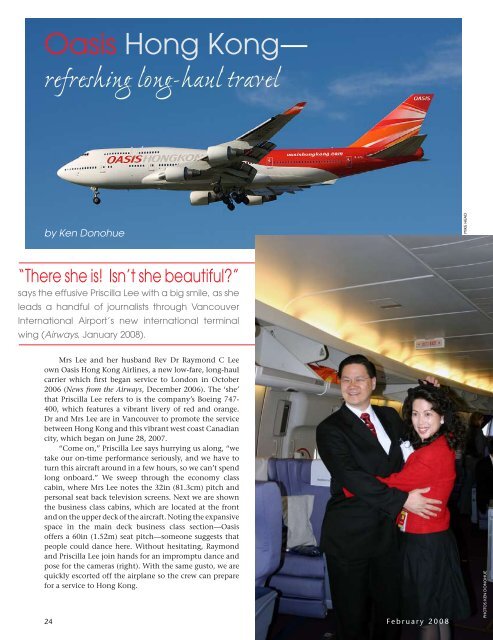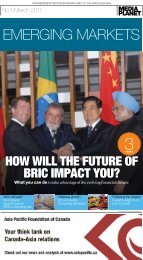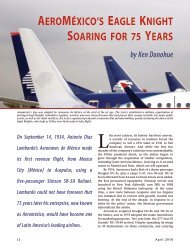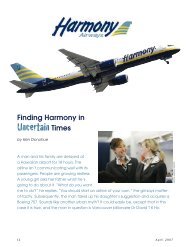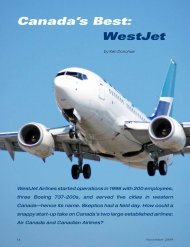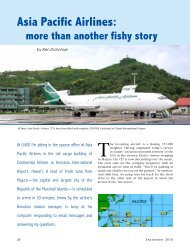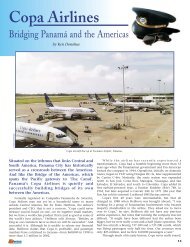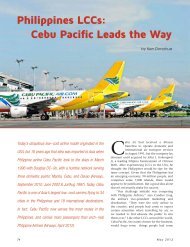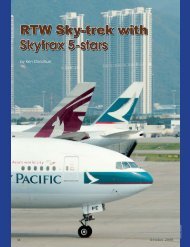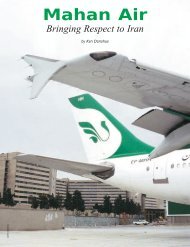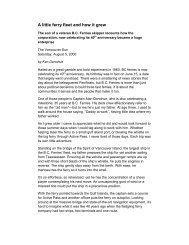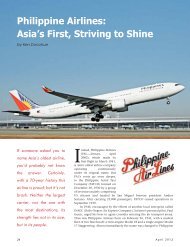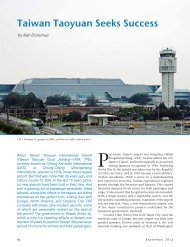Oasis Hong Kong— refreshing long-haul travel - Ken Donohue
Oasis Hong Kong— refreshing long-haul travel - Ken Donohue
Oasis Hong Kong— refreshing long-haul travel - Ken Donohue
Create successful ePaper yourself
Turn your PDF publications into a flip-book with our unique Google optimized e-Paper software.
<strong>Oasis</strong> <strong>Hong</strong> <strong>Kong—</strong><br />
<strong>refreshing</strong> <strong>long</strong>-<strong>haul</strong> <strong>travel</strong><br />
by <strong>Ken</strong> <strong>Donohue</strong> MIKE HEAD<br />
“There she is! Isn’t she beautiful?”<br />
says the effusive Priscilla Lee with a big smile, as she<br />
leads a handful of journalists through Vancouver<br />
International Airport’s new international terminal<br />
wing (Airways, January 2008).<br />
Mrs Lee and her husband Rev Dr Raymond C Lee<br />
own <strong>Oasis</strong> <strong>Hong</strong> Kong Airlines, a new low-fare, <strong>long</strong>-<strong>haul</strong><br />
carrier which first began service to London in October<br />
2006 (News from the Airways, December 2006). The ‘she’<br />
that Priscilla Lee refers to is the company’s Boeing 747-<br />
400, which features a vibrant livery of red and orange.<br />
Dr and Mrs Lee are in Vancouver to promote the service<br />
between <strong>Hong</strong> Kong and this vibrant west coast Canadian<br />
city, which began on June 28, 2007.<br />
“Come on,” Priscilla Lee says hurrying us a<strong>long</strong>, “we<br />
take our on-time performance seriously, and we have to<br />
turn this aircraft around in a few hours, so we can’t spend<br />
<strong>long</strong> onboard.” We sweep through the economy class<br />
cabin, where Mrs Lee notes the 32in (81.3cm) pitch and<br />
personal seat back television screens. Next we are shown<br />
the business class cabins, which are located at the front<br />
and on the upper deck of the aircraft. Noting the expansive<br />
space in the main deck business class section—<strong>Oasis</strong><br />
offers a 60in (1.52m) seat pitch—someone suggests that<br />
people could dance here. Without hesitating, Raymond<br />
and Priscilla Lee join hands for an impromptu dance and<br />
pose for the cameras (right). With the same gusto, we are<br />
quickly escorted off the airplane so the crew can prepare<br />
for a service to <strong>Hong</strong> Kong.<br />
24 F e b r u a r y 2 0 0 8<br />
PHOTOS: KEN DONOHUE
Stephen Miller, an industry veteran, developed the<br />
idea of <strong>Oasis</strong> <strong>Hong</strong> Kong. And referring to Priscilla Lee’s<br />
lively tour, he says that it is passionate owners like the<br />
Lees who help make airlines successful. Miller had his<br />
start in the industry in 1972, when he served as regional<br />
VP Asia-Pacific for Cargolux. After a stint with Guinness<br />
Peat Aviation, the Irish commercial aircraft sales and<br />
leasing company founded by the late Tony Ryan, Miller<br />
began <strong>Hong</strong> Kong’s Dragonair (Airways, September 2006),<br />
and served as the airline’s CEO until he left when the<br />
Swire Group bought into Dragonair in 1990. For the next<br />
15 years, Miller worked as a consultant.<br />
During his time with Dragonair, Miller noticed an<br />
interesting trend in passenger traffic that an airline like<br />
<strong>Oasis</strong> could serve. “Approximately 20 percent of the trans-<br />
Pacific market between North America and <strong>Hong</strong> Kong was<br />
<strong>travel</strong>ling through a third country, such as Taiwan, Japan,<br />
and South Korea, because they couldn’t find a seat on a<br />
nonstop flight at a price they could afford,” says Miller.<br />
He also noted a similar phenomenon between London<br />
and <strong>Hong</strong> Kong, where a large proportion of passengers<br />
were flying between the two cities via the Middle East.<br />
“People don’t really want to sit around an airport for<br />
hours waiting for a connecting flight,” he asserts.<br />
This knowledge gave Miller the inspiration to start<br />
a low-fare, <strong>long</strong>-<strong>haul</strong> airline, based in <strong>Hong</strong> Kong. “If we<br />
bought aircraft at the right price and the market stayed<br />
strong, then I was sure it could work,” he says. “You have<br />
to have a feel for the business.”<br />
Analyzing traffic patterns and wanting to start an<br />
airline is the easy part. Finding the money to propel the<br />
airline off the ground is quite another, especially in an<br />
industry that is capital-intensive and fickle. Miller first<br />
met Raymond Lee by chance as the two were standing in<br />
a queue at a special screening of the Mel Gibson movie<br />
The Passion of the Christ. During their brief encounter,<br />
Miller learned that the Lees were property developers,<br />
with most of their work on the East Coast of the USA.<br />
Coincidentally, Miller’s office was in the same building<br />
as the Lees. Miller thought Raymond Lee an interesting<br />
man, and someone he could talk to about his airline idea.<br />
As it turned out, that chance meeting at the movie led<br />
to Miller’s first investor. “With Dragonair it took three to<br />
four years to find investors,” admits Miller. “With <strong>Oasis</strong> it<br />
only took three to four months.” He tells Airways that the<br />
Lees are in it for the <strong>long</strong> term, and they know they have<br />
to be patient. The initial capital was $100 million, with<br />
the Lees contributing 60% and Dr Allan Wong, chairman<br />
and CEO of VTech Holdings, the other 40%.<br />
Given their outlook on life, it’s not surprising that<br />
the Lees would find themselves owning an airline. “As<br />
young people we were fortunate to <strong>travel</strong>, and those<br />
experiences broadened our personal and professional<br />
lives,” says Raymond Lee. “It’s important for people to<br />
see the world, and so when we started we gave 400 tickets<br />
to university students.”<br />
A i r w a y s<br />
While it may have been relatively easy for Miller to<br />
secure the start-up capital, it was a challenge to persuade<br />
the shareholders that <strong>long</strong>-<strong>haul</strong> was the way to go. Miller<br />
explains that short-<strong>haul</strong> is much more competitive and<br />
difficult to organize. “You don’t have the same lead<br />
time that you do with a <strong>long</strong>-<strong>haul</strong> operation,” he notes,<br />
adding, “we are able to put on a promotion if demand<br />
looks low.” He demonstrates this by pulling out from his<br />
desk a piece of paper which shows that in five months’<br />
time 30% of the seats have already been booked.<br />
If Dr Lee was first skeptical of the <strong>long</strong>-<strong>haul</strong> model,<br />
he’s a convert now. “By flying point-to-point, we can<br />
save money without compromising safety and comfort,”<br />
he says. “Long-<strong>haul</strong> flying is like driving your car on the<br />
highway, as opposed to driving in the city.”<br />
<strong>Oasis</strong> is the first new <strong>long</strong>-<strong>haul</strong> scheduled passenger<br />
carrier to be based in <strong>Hong</strong> Kong in 60 years, and Miller<br />
says the city is a good place to base an airline. He notes<br />
that <strong>Hong</strong> Kong is perfectly situated in the middle of<br />
eastern Asia, and has a well-developed market. “<strong>Hong</strong><br />
Kong is a leisure and business destination and origin,”<br />
says Miller. “More than 40 million people live in the<br />
Pearl River Delta region, and <strong>Hong</strong> Kong is the biggest<br />
air cargo airport in the world. All of this helps grow a<br />
successful airline.”<br />
Currently, <strong>Oasis</strong> operates three Boeing 747-400s,<br />
with two more due by April 2008. Two are ex-Singapore<br />
Airlines, while the others used to fly for ANA (All Nippon<br />
Airways). Miller believes that the 747-400 is a good<br />
aircraft for the routes <strong>Oasis</strong> flies, but did also consider<br />
the 777 and the Airbus A340. “It has been challenging<br />
finding aircraft, because some airlines have been holding<br />
25
on to their 747s while they wait for delayed deliveries of<br />
the A380.”<br />
On one flight, I was pleasantly surprised by the tail-<br />
and belly-mounted cameras on the former ANA aircraft,<br />
which offered excellent forward-looking views of our taxi<br />
and takeoff from <strong>Hong</strong> Kong. Once airborne, the belly<br />
camera was turned on, allowing us to see the scores of<br />
boats below in Victoria Harbour. As we neared Vancouver,<br />
the cameras were switched on again, and we were treated<br />
to a pilot’s view of our approach and landing.<br />
Miller says that the 747-400 is good for mature<br />
markets, such as London and Vancouver, but with loads<br />
of less than 60% that particular type can lose an airline<br />
a lot of money. <strong>Oasis</strong> recently secured $30 million in<br />
equity infusion from Value Partners, a <strong>Hong</strong> Kong-based<br />
investment company, to acquire nine more 747s by 2011<br />
to expand its route network.<br />
<strong>Oasis</strong> <strong>Hong</strong> Kong’s first route was to London<br />
(Gatwick), followed eight months later with service to<br />
Vancouver. Our strategy, like other low-cost carriers, is<br />
to stimulate and grow the market,” says Miller. “In fact,<br />
we know we have stimulated the market by increasing<br />
outbound traffic to the UK by nearly 20 percent in just<br />
the first six months of operations, and we expect it to<br />
be even more dramatic with Vancouver. There is an<br />
umbilical cord-like relationship between <strong>Hong</strong> Kong<br />
and Vancouver.”<br />
<strong>Oasis</strong> offers daily service to London and six flights a<br />
week to Vancouver, although to meet demand during the<br />
busy Christmas period the airline provided daily service<br />
to Vancouver. Canada isn’t known for having the most<br />
open skies in the world and Miller would “definitely like<br />
to see further liberalization in the Canadian market.”<br />
The current agreement allows two carriers each from<br />
Canada and <strong>Hong</strong> Kong to fly between the two. Air<br />
Canada and Cathay Pacific Airways are allowed unlimited<br />
frequencies, while the second carriers are each restricted<br />
to ten flights a week. According to <strong>Oasis</strong>, the respective<br />
governments have agreed to discuss this issue. “We’d<br />
like to see unlimited frequencies,” says Miller. “We’re<br />
confident we can stimulate the market without hurting<br />
the incumbents. We’re not here to steal someone’s lunch<br />
so they can steal it back from us.”<br />
Miller suggests that the airline would like to<br />
eventually offer double-daily flights between Vancouver<br />
and <strong>Hong</strong> Kong. The challenge in gaining access to the<br />
Canadian market is in distinct contrast to the true open<br />
skies agreement that exists between <strong>Hong</strong> Kong and the<br />
United Kingdom (UK), which Miller notes is partly due<br />
to a shared history and enlightenment on the part of the<br />
regulators. Several carriers currently operate 14 flights a<br />
day between <strong>Hong</strong> Kong and the UK. Access to continental<br />
Europe, on the other hand, is very different with many<br />
governments protective of their national airlines, such as<br />
Lufthansa, Air France, and Alitalia. <strong>Oasis</strong> is eyeing service<br />
to Cologne [Köln], Berlin, Milan [Milano], Chicago,<br />
26<br />
CEO Stephen Miller; business class meal service and cabin crew on a<br />
Vancouver service (opposite).<br />
and San Francisco. Miller reveals to Airways that <strong>Oasis</strong><br />
is now interested in San Francisco rather than Oakland,<br />
California, as had previously been suggested, and while<br />
it has yet to apply for routes to Australia, he notes that<br />
Sydney and Melbourne are prime destinations.<br />
From his office window, Miller has an excellent view<br />
of <strong>Hong</strong> Kong International Airport, home to Cathay<br />
Pacific, consistently rated as one of the best airlines in the<br />
world. But he isn’t too concerned about Cathay putting<br />
the squeeze on <strong>Oasis</strong> despite the former operating 17<br />
flights a week between <strong>Hong</strong> Kong and Vancouver, and<br />
reducing its economy class fares to an unprecedented<br />
$698 in response to <strong>Oasis</strong> entering the market. “We’re<br />
gaining the people who can now fly to <strong>Hong</strong> Kong on a<br />
whim,” says Miller. “Sure, there would be a major crunch<br />
if there is a downturn in the market, and lots of seats go<br />
empty over the Pacific.”<br />
As low-cost airlines around the globe have done,<br />
<strong>Oasis</strong> has forced traditional companies to lower fares.<br />
Both Cathay Pacific and Air Canada are offering fares well<br />
into 2008 between Vancouver and <strong>Hong</strong> Kong for $700.<br />
Before <strong>Oasis</strong> entered the market, nonstop fares between<br />
the two cities rarely dropped below $1,100.<br />
While other airlines may reduce their economy<br />
class fares, the place where <strong>Oasis</strong> can really save the<br />
<strong>travel</strong>ler money is in its premium cabin, where return<br />
fares can be had for as low as $1,600. In contrast, Air<br />
Canada and Cathay charge more than $4,700. Raymond<br />
Lee is quick to point out that <strong>Oasis</strong> is not about what<br />
Cathay is or isn’t. “<strong>Hong</strong> Kong is a very mature market,<br />
with high demands,” he says. “They want three things;<br />
save money, save time, and high quality service.” I<br />
spoke to one customer who <strong>travel</strong>s between Vancouver<br />
and <strong>Hong</strong> Kong several times a year. He is now able to<br />
enjoy <strong>Oasis</strong> business class, whereas before he was able<br />
to afford only economy.<br />
P a s s e n g e r s i n e c o n o m y a r e o f f e r e d t w o<br />
complimentary hot meals. Alcoholic beverages and<br />
snacks, a<strong>long</strong> with an amenity kit and advanced seat<br />
selection, can be purchased for a fee, with exit rows<br />
F e b r u a r y 2 0 0 8
attracting a premium charge. Business class passengers<br />
have access to dedicated check-in and lounge access.<br />
On this editor’s flights between Vancouver and <strong>Hong</strong><br />
Kong, service was excellent, equal to some of the best<br />
airlines in Asia. More than once, I had to remind myself<br />
that I was flying on a low-cost airline. One flight attendant<br />
addressed each upper deck passenger by name. The food<br />
was delicious, and the salmon was restaurant quality. My<br />
only gripe was the plastic cutlery in business class. When<br />
I mention this to Miller, he smiles. “Before we started<br />
flying we held some focus groups, and they told us not to<br />
get too fancy with the food and presentation, and metal<br />
cutlery. Once we started, everyone was complaining about<br />
the plastic cutlery in business class.” <strong>Oasis</strong> has ordered<br />
a year’s supply of plastic utensils, but once the stock is<br />
gone, business passengers will probably find a metal fork,<br />
knife, and spoon.<br />
The focus groups also told the airline that it need<br />
offer only water to economy class customers and charge<br />
extra for soft drinks, but again people complained. In<br />
response, <strong>Oasis</strong> now provides complimentary soft drinks.<br />
“Focus groups are fine, but nothing can replace the real<br />
experience,” remarks Miller. “We’re learning, and as a<br />
small airline we can change things quickly.” Indeed, <strong>Oasis</strong><br />
is very responsive to customer comments. If passengers<br />
register their mobile (cell phone) number when making<br />
a reservation, they will receive a text message from Miller<br />
thanking them for flying with <strong>Oasis</strong>, and inviting them<br />
to provide feedback on their experience with the airline.<br />
And unlike some companies where emails become lost<br />
in an inbox, Miller is quick to respond. “I receive about<br />
40 emails a day from passengers,” he says. “They come<br />
directly to me, and I spend the first hour of my day<br />
responding. The feedback is very useful.”<br />
<strong>Oasis</strong> is a point-to-point airline, although it has<br />
negotiated some creative agreements with several other<br />
airlines—including Jetstar Asia, Cebu Pacific, China<br />
Airlines, and <strong>Hong</strong> Kong Airlines—to offer onward<br />
connections beyond <strong>Hong</strong> Kong. “It was difficult at first<br />
because those airlines weren’t interested in talking to us,<br />
but once they knew <strong>Oasis</strong> could bring them business they<br />
were more willing,” relates Miller. The airline has also<br />
had discussions with Canada’s WestJet (Airways, January<br />
A i r w a y s<br />
PHOTOS: KEN DONOHUE<br />
1999 & May 2003), which could give <strong>Oasis</strong> access to an<br />
extensive Canadian network.<br />
There are bound to be skeptics with the launch<br />
of any airline. The industry has a habit of humbling<br />
even the most experienced businessperson. But with<br />
committed and passionate ownership and management,<br />
<strong>Oasis</strong> <strong>Hong</strong> Kong Airlines might just be able to pull it off.<br />
Can one airline change the <strong>long</strong>-<strong>haul</strong> business much the<br />
way low-cost carriers around the world have done to the<br />
short-<strong>haul</strong> market? Probably not, but <strong>Oasis</strong> has already<br />
forced traditional airlines serving <strong>long</strong> established routes<br />
to react. If this is sustainable then it is good news indeed<br />
for the consumer. ✈<br />
<strong>Oasis</strong> <strong>Hong</strong> Kong Airlines<br />
IATA: O8 IATA: OHK Radio: <strong>Oasis</strong><br />
8/F, One Citygate Tel: +852 2524 5525<br />
20 Tat Tung Road Fax: +852 3628 0688<br />
Tung Chung<br />
Lantau Island<br />
<strong>Hong</strong> Kong<br />
Website: www.oasishongkong.com<br />
Email: info@oasishongkong.com<br />
FAST FACTS<br />
Founded: February 2005<br />
Start date: October 26, 2006<br />
Ownership: Rev Dr Raymond C Lee & Priscilla H Lee<br />
(60%); Dr Allan Wong (40%)<br />
CEO: Stephen H Miller<br />
Cities served: <strong>Hong</strong> Kong, London (LGW), Vancouver<br />
Fleet<br />
Type N o Seats Engines<br />
Boeing 747-400 2 C81Y278 PW PW4056<br />
1 C71Y268 GECF6 80C2B1F<br />
On order<br />
Boeing 747-400 2 C71Y268 GE CF6-80C2B1F<br />
due by April 2008<br />
27


